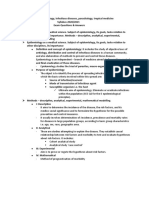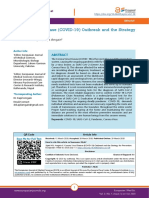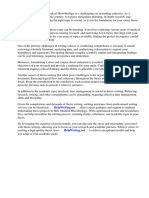Epidemic 2021 For Uploading 2
Epidemic 2021 For Uploading 2
Uploaded by
Jewel Mae DanielCopyright:
Available Formats
Epidemic 2021 For Uploading 2
Epidemic 2021 For Uploading 2
Uploaded by
Jewel Mae DanielOriginal Title
Copyright
Available Formats
Share this document
Did you find this document useful?
Is this content inappropriate?
Copyright:
Available Formats
Epidemic 2021 For Uploading 2
Epidemic 2021 For Uploading 2
Uploaded by
Jewel Mae DanielCopyright:
Available Formats
EPIDEMICS
Epidemics
Ma. Lucila M. Perez, MD, MSc
PREVENTIVE & COMMUNITY MEDICINE 2 YL 2
EPIDEMICS
Definitions
John Hopkins School of Public Health
• Hyperendemic – persistent high levels of disease occurrence
• Outbreak - an epidemic in relatively limited geographic or focal area
PREVENTIVE & COMMUNITY MEDICINE 2 YL 2
EPIDEMICS
Epidemics in the 21st century
Faster and further with greater impact:
• Spread widely, more quickly, affecting more people
• Produce ruinous impact on economy (global), disrupt
travel, trade, livelihoods
PREVENTIVE & COMMUNITY MEDICINE 2 YL 2
EPIDEMICS
WHICH IS AN OUTBREAK / EPIDEMIC?
✔ 1. 10 members of the swim team
️ vomiting after eating at
Restaurant A
X 2. 30 Dengue cases every month for
the past year
✔ 3. 196 Measles cases in NCR from
️ January 1-19, 2019
PREVENTIVE & COMMUNITY MEDICINE 2 YL 2
EPIDEMICS
Coronavirus COVID-19, Philippines
January – March 2020
200 187
180
160
140 142
140
120 111
100 89
80 64
60 52
40 33
20 5 6 10
3
0
30-Jan 5-Mar 6-Mar 8-Mar 9-Mar 11-Mar 12-Mar 13-Mar 14-Mar 15-Mar 16-Mar 17-Mar
PREVENTIVE & COMMUNITY MEDICINE 2 YL 2
EPIDEMICS
EPIDEMIC PHASES
Introduction Localized Amplification Reduced
or emergence transmission Transmission
1st Phase: Emergence in a community
2nd Phase: Localized transmission or sporadic infections occur
3rd Phase: Human to human transmission causes a sustained outbreak
4th Phase: Reduced transmission because population acquires
immunity or effective interventions control the spread
WHO, 2018
PREVENTIVE & COMMUNITY MEDICINE 2 YL 2
EPIDEMICS
Why do Epidemics Occur?
1. New disease
A. Introduction of a new disease
B. Recognition for the first time of an already existing
disease known by another name
C. Diseases previously affecting only lower animals
PREVENTIVE & COMMUNITY MEDICINE 2 YL 2
EPIDEMICS
Why do Epidemics Occur?
2. Flare up of an old or existing disease, implying
changes in :
a. Environment – favorable conditions for survival of
vectors & enhanced mode of transmission
ex. calamities
b. Agent – inc. virulence, new strain, inc. capacity to
multiply
c. Host – inc. susceptibility : lowering of general
resistance, decrease herd immunity
PREVENTIVE & COMMUNITY MEDICINE 2 YL 2
EPIDEMICS
Herd Immunity Threshold
PREVENTIVE & COMMUNITY MEDICINE 2 YL 2
EPIDEMICS
Epidemic Patterns
• According to manner of spread
1. Common – source: exposed to same source
a) Point source – cases all exposed to same source during brief period of time,
cases occur within one incubation period
b) Continuous source – same source during more than a brief period
PREVENTIVE & COMMUNITY MEDICINE 2 YL 2
EPIDEMICS
Epidemic Curves
Exposure
Salmonella outbreak at wedding reception
POINT SOURCE EPIDEMIC CURVE
Explosive exposure (steep upslope) and a more gradual downslope
PREVENTIVE & COMMUNITY MEDICINE 2 YL 2
EPIDEMICS
Epidemic Curves
CONTINUOUS SOURCE CURVE
Range of exposures and incubation periods tend to flatten and widen the peaks
PREVENTIVE & COMMUNITY MEDICINE 2 YL 2
EPIDEMICS
Epidemic Patterns
2. Propagated: Infectious agent passes from one host to
another, cases occur over >1 incubation period
a) directly from person to person (ex. handshaking or kissing), or
b) indirectly via vectors (ex. malaria ) or vehicles (ex. HIV )
3. Mixed
PREVENTIVE & COMMUNITY MEDICINE 2 YL 2
EPIDEMICS
PROPAGATED (PROGRESSIVE) EPIDEMIC CURVE
Peaks occur consistent with incubation period of the disease
PREVENTIVE & COMMUNITY MEDICINE 2 YL 2
EPIDEMICS
Epidemic Curves
E. Coli 0157 in Nursery
E.Coli 0157 in nursery
MIXED EPIDEMIC CURVE
Characteristics of both common and propagated
epidemics Ex. Often in food-borne infectious agents
PREVENTIVE & COMMUNITY MEDICINE 2 YL 2
EPIDEMICS
USES OF EPIDEMIC CURVES
1) Type of exposure from its shape
2) Suggest possible agents - if time of exposure is known
PREVENTIVE & COMMUNITY MEDICINE 2 YL 2
EPIDEMICS
USES OF EPIDEMIC CURVES
3) ID time of onset - if agent is known
PREVENTIVE & COMMUNITY MEDICINE 2 YL 2
EPIDEMICS
Control and Preventive measures
1. Eradication/elimination of disease agents at source
2. Interrupt / closure of transmission
3. Exhaustion or protection of susceptibles
PREVENTIVE & COMMUNITY MEDICINE 2 YL 2
EPIDEMICS
Control and Preventive measures
___
1 1. Remove source of contamination
___
1 2. Treat the infected person
___
2 3. Physical distancing
1. Eradication / elimination of disease agents at source
2. Interrupt / closure of transmission
3. Exhaustion of susceptibles
PREVENTIVE & COMMUNITY MEDICINE 2 YL 2
EPIDEMICS
Physical Distancing and COVID-19 infection
Unlike other diseases, there is no known effective drug or vaccine against this novel virus.
Drastic mitigation measures such as social distancing and lockdowns could delay the
epidemic and flatten the curve thus, reducing the burden on hospitals and infrastructure.
PREVENTIVE & COMMUNITY MEDICINE 2 YL 2
EPIDEMICS
5 Stages of Response Interventions
Response Anticipation Early Containment. Control & Elimination or
Interventions detection Mitigation Eradication
EPIDEMIC Introduction Localized Amplification Reduced
PHASES or emergence transmission Transmission
The phases of epidemics, as described before, will dictate
the response and the sequence of interventions
PREVENTIVE & COMMUNITY MEDICINE 2 YL 2
EPIDEMICS
Stay safe everyone! STAY HOME
PREVENTIVE & COMMUNITY MEDICINE 2 YL 2
You might also like
- Epidemiology Exam Questions and AnswersDocument107 pagesEpidemiology Exam Questions and Answersdimitrios81% (37)
- Meningitis MENINGITIS Meningococcal MeningitisDocument46 pagesMeningitis MENINGITIS Meningococcal Meningitistummalapalli venkateswara raoNo ratings yet
- Materi 1 Dr. Apt. Diana Laila Ramatillah, M.farmDocument32 pagesMateri 1 Dr. Apt. Diana Laila Ramatillah, M.farmDimas RfNo ratings yet
- 5.1.3. Efficacy of Antimicrobial PreservationDocument3 pages5.1.3. Efficacy of Antimicrobial PreservationAlma KunicNo ratings yet
- HIDII Global Epdemic Precautions 2020-Dr MamtaniDocument21 pagesHIDII Global Epdemic Precautions 2020-Dr Mamtanif3er3No ratings yet
- Human MonkeypoxDocument8 pagesHuman Monkeypoxlakshay kumarNo ratings yet
- Pandemic Preparedness PlanDocument40 pagesPandemic Preparedness PlanMurali Vallipuranathan100% (2)
- Epi#3Document19 pagesEpi#3JNo ratings yet
- PSM Volume 2 (2015) PDFDocument219 pagesPSM Volume 2 (2015) PDFLeo GyiNo ratings yet
- The Beast 2020Document43 pagesThe Beast 2020Toma BichirNo ratings yet
- NCMB312 Communicable DiseasesDocument2 pagesNCMB312 Communicable Diseasessammyfrancisco134No ratings yet
- MicroDocument58 pagesMicrolovelyNo ratings yet
- Pademic and EpidemicsDocument16 pagesPademic and EpidemicsTheertha PrejeeshNo ratings yet
- Diagnosis and Management of COVID-19 Disease: Public HealthDocument4 pagesDiagnosis and Management of COVID-19 Disease: Public HealthLOLOLONo ratings yet
- Medical Surgical Nursing Module 2Document6 pagesMedical Surgical Nursing Module 2JAY TOM BOLIVARNo ratings yet
- COVID-19, Chronicle of An Expected Pandemic: EditorialDocument6 pagesCOVID-19, Chronicle of An Expected Pandemic: EditorialTheYeye97No ratings yet
- Konsep Dasar EpidemiologiDocument22 pagesKonsep Dasar Epidemiologiari purwandiniNo ratings yet
- Covid 2020 ExcelenteDocument21 pagesCovid 2020 ExcelenteLuis Miguel VillanuevaNo ratings yet
- Jamaophthalmology Sommer 2020 Ic 200013 PDFDocument2 pagesJamaophthalmology Sommer 2020 Ic 200013 PDFfaisaladeNo ratings yet
- Plague Binder Chapter.2008.FINAL Id313Document13 pagesPlague Binder Chapter.2008.FINAL Id313nrtNo ratings yet
- Diagnostic Tests: Leon) (Flaviviruses) (Common in The Phil.) P. OvaleDocument12 pagesDiagnostic Tests: Leon) (Flaviviruses) (Common in The Phil.) P. OvaleJUANJOSEFOXNo ratings yet
- Guidelines For Management of Monkeypox DiseaseDocument23 pagesGuidelines For Management of Monkeypox DiseaseMinerva Medical Treatment Pvt LtdNo ratings yet
- Causative Agents: Leon) (Flaviviruses) (Common in The Phil.) P. OvaleDocument12 pagesCausative Agents: Leon) (Flaviviruses) (Common in The Phil.) P. OvaleJUANJOSEFOXNo ratings yet
- Epidemiología GeneralDocument31 pagesEpidemiología GeneralCristian MamaniNo ratings yet
- Emerging and Reemerging DiseasesDocument33 pagesEmerging and Reemerging DiseasesPrecious BernabeNo ratings yet
- Presentation 5 The Infection Control Risk Assessment and PlanDocument24 pagesPresentation 5 The Infection Control Risk Assessment and PlanLany PasauNo ratings yet
- MPH 5203 Communicable DiseasesDocument134 pagesMPH 5203 Communicable DiseasesOLIVIERNo ratings yet
- Causative Agents: Leon) (Flaviviruses) (Common in The Phil.) P. OvaleDocument12 pagesCausative Agents: Leon) (Flaviviruses) (Common in The Phil.) P. OvaleJUANJOSEFOXNo ratings yet
- Herd Immunity Pada Covid 19 - Kelompok 1Document14 pagesHerd Immunity Pada Covid 19 - Kelompok 1NaifahLuthfiyahPutriNo ratings yet
- Disease Outbreak 2013Document60 pagesDisease Outbreak 2013venuNo ratings yet
- DYNAMICS OF DISEASE TRANSMISSION - MPH - DHA - 2011 - EdtDocument71 pagesDYNAMICS OF DISEASE TRANSMISSION - MPH - DHA - 2011 - EdtTin WannNo ratings yet
- Corona OriginDocument5 pagesCorona Originquanghien1410No ratings yet
- 1 McCaffrey - Global CementDocument26 pages1 McCaffrey - Global CementJohnNo ratings yet
- Running Head: Community Health and Population-Focused Nursing 1Document6 pagesRunning Head: Community Health and Population-Focused Nursing 1Best EssaysNo ratings yet
- Sajed & Amgain, 2020Document3 pagesSajed & Amgain, 2020NUR ATIKA BINTI HALIMNo ratings yet
- Module 1.2 - Virology and ImmunologyDocument19 pagesModule 1.2 - Virology and ImmunologyTom Sawyer RabbitryNo ratings yet
- Biological WeaponsDocument43 pagesBiological WeaponsYasmina BadrNo ratings yet
- Decelerate Human Transmission of Covid-19 Philippine ExperienceDocument63 pagesDecelerate Human Transmission of Covid-19 Philippine ExperienceYves Balete LabradorNo ratings yet
- Communicable Disease NursingDocument9 pagesCommunicable Disease NursingVied FranzuelaNo ratings yet
- Epidemiology Exam Questions and AnswersDocument107 pagesEpidemiology Exam Questions and AnswersilerioluwaibitoyeNo ratings yet
- 3 MICRO 12 - Emerging and Re-Emerging Infectious Diseases - Dr. RosarioDocument7 pages3 MICRO 12 - Emerging and Re-Emerging Infectious Diseases - Dr. RosarioyayayanizaNo ratings yet
- Epidemiology and Public HealthDocument2 pagesEpidemiology and Public HealthLady DanielleNo ratings yet
- WHO Global Pandemic Phases and The Stages For Federal Government ResponseDocument4 pagesWHO Global Pandemic Phases and The Stages For Federal Government ResponseMara Luisa PanopioNo ratings yet
- Pathfit PrelimsDocument2 pagesPathfit Prelimsmikhyla.cardenoNo ratings yet
- MODULE 1 and 2 RevisedDocument50 pagesMODULE 1 and 2 RevisedMaricar RosasNo ratings yet
- Coronavirus Disease 2019 (COVID-19) : Because Learning Changes EverythingDocument29 pagesCoronavirus Disease 2019 (COVID-19) : Because Learning Changes EverythingDennis MuthusiNo ratings yet
- Covid-19 On Pediatric Patients Part 1 (10-15 Solano)Document25 pagesCovid-19 On Pediatric Patients Part 1 (10-15 Solano)Deomicah SolanoNo ratings yet
- All Viral DiseasesDocument59 pagesAll Viral DiseasesarianatorghimireNo ratings yet
- Diagnosis and Management of COVID-19 Disease: Public HealthDocument4 pagesDiagnosis and Management of COVID-19 Disease: Public HealthSam HaileyNo ratings yet
- Covid-19 Malaysia Sars-Cov-2: KeywordsDocument3 pagesCovid-19 Malaysia Sars-Cov-2: KeywordsBellaNo ratings yet
- 2016 - Code I & Code JDocument6 pages2016 - Code I & Code JJannah Miftahul JannahNo ratings yet
- Quarter 4 Lesson 2 BioterrorismDocument6 pagesQuarter 4 Lesson 2 Bioterrorismezra serranoNo ratings yet
- Case-Control Study of Patient Characteristics, Knowledge of The COVID-19 Disease, Risk Behaviour and Mental State in Patients Visiting An Emergency Room With COVID-19 Symptoms in The NetherlandsDocument13 pagesCase-Control Study of Patient Characteristics, Knowledge of The COVID-19 Disease, Risk Behaviour and Mental State in Patients Visiting An Emergency Room With COVID-19 Symptoms in The NetherlandsRevi RidayantiNo ratings yet
- Communicable DiseasesDocument32 pagesCommunicable DiseasesPatty RomeroNo ratings yet
- Unit 8Document43 pagesUnit 8Mudin HajiNo ratings yet
- Pencegahan Dan Penanggulangan Penyakit Menular: Nunuk Nugrohowati, DRG, MS Departemen IKK-IKM UPNDocument61 pagesPencegahan Dan Penanggulangan Penyakit Menular: Nunuk Nugrohowati, DRG, MS Departemen IKK-IKM UPNImam Muhamad RissandyNo ratings yet
- Health Policy: Andrea Remuzzi, Giuseppe RemuzziDocument4 pagesHealth Policy: Andrea Remuzzi, Giuseppe RemuzziMario DavilaNo ratings yet
- Personal View: Annelies Wilder-Smith, Calvin J Chiew, Vernon J LeeDocument6 pagesPersonal View: Annelies Wilder-Smith, Calvin J Chiew, Vernon J LeeDalibor P. DrljacaNo ratings yet
- Chikunguña PROTOCOLODocument17 pagesChikunguña PROTOCOLOKATHE9007No ratings yet
- Week 2Document38 pagesWeek 2Ravi CharanNo ratings yet
- Mckinsey Briefing NoteDocument12 pagesMckinsey Briefing NoteGONE RAJASHEKERNo ratings yet
- Arms 1Document1 pageArms 1Jewel Mae DanielNo ratings yet
- Thank You Letter To SponsorsDocument1 pageThank You Letter To SponsorsJewel Mae DanielNo ratings yet
- Arms 4Document2 pagesArms 4Jewel Mae DanielNo ratings yet
- Arms 0Document2 pagesArms 0Jewel Mae DanielNo ratings yet
- CF3 - TemplateDocument2 pagesCF3 - TemplateJewel Mae DanielNo ratings yet
- BSR 1.09.v2 Journal Article 4 Viral Invasion of Host CellsDocument17 pagesBSR 1.09.v2 Journal Article 4 Viral Invasion of Host CellsJewel Mae DanielNo ratings yet
- Bfhi Session 17 SlidesDocument6 pagesBfhi Session 17 SlidesJewel Mae DanielNo ratings yet
- Micp ReviewerDocument30 pagesMicp ReviewerFrancisca NairNo ratings yet
- English Speech of Nursing: "Speech About Hiv/Aids Disease"Document2 pagesEnglish Speech of Nursing: "Speech About Hiv/Aids Disease"Budi AtmikaNo ratings yet
- Tabel RBK Bakteri Escherichia ColiDocument5 pagesTabel RBK Bakteri Escherichia ColiItis MayantiNo ratings yet
- Bacteriology Handouts From Sir PalmaresDocument30 pagesBacteriology Handouts From Sir PalmaresTin BabistaNo ratings yet
- Hepatitis EDocument2 pagesHepatitis EMahboob IqbalNo ratings yet
- A Comparative Study of Antibacterial Activity of Leaves and Latex of Jatropha Curcas LDocument5 pagesA Comparative Study of Antibacterial Activity of Leaves and Latex of Jatropha Curcas Lanna luthfiahNo ratings yet
- Goat DiseasesDocument33 pagesGoat DiseasesThe Municipal AgriculturistNo ratings yet
- CHN Immunization NotesDocument9 pagesCHN Immunization NotesJustin AncogNo ratings yet
- Neonatal Sepsis ThesisDocument82 pagesNeonatal Sepsis Thesisnandhus2227100% (1)
- Food Contamination Worksheet 2Document3 pagesFood Contamination Worksheet 2compilationsNo ratings yet
- MC3 Microbiology and Parasitology NotesDocument15 pagesMC3 Microbiology and Parasitology NotesKim Erida QuezonNo ratings yet
- Fermented PrelimsDocument11 pagesFermented PrelimsCarlos Alberto Altamirano CahuancamaNo ratings yet
- POST CHRISTMAS - Glasgow - DTMH - Timetable - 23-24 - 13DEC23Document3 pagesPOST CHRISTMAS - Glasgow - DTMH - Timetable - 23-24 - 13DEC23nathanaellee92No ratings yet
- MCQ BiologyDocument3 pagesMCQ BiologyThayumanavanNo ratings yet
- Second Ann APSIC 2024 - IDRDocument22 pagesSecond Ann APSIC 2024 - IDRmaryo williamNo ratings yet
- Favipiravir - Wikipedia PDFDocument39 pagesFavipiravir - Wikipedia PDFDebi GhoshNo ratings yet
- (23003235 - Bulletin of The Veterinary Institute in Pulawy) Microbiological Quality of Compound Feed Used in PolandDocument6 pages(23003235 - Bulletin of The Veterinary Institute in Pulawy) Microbiological Quality of Compound Feed Used in PolandfirewNo ratings yet
- Cns InfectionsDocument141 pagesCns InfectionsReda AlyNo ratings yet
- Vaccines CircaDocument10 pagesVaccines CircamariavillaresNo ratings yet
- Intestinal Cestodes: DR Mohiedden M Abdul-FattahDocument27 pagesIntestinal Cestodes: DR Mohiedden M Abdul-FattahMicroscopeGeekNo ratings yet
- Ujiaktivitas Antibakteri Ekstrak KULIT BUAH MANGGIS (Gardnia Mangostana Linn)Document5 pagesUjiaktivitas Antibakteri Ekstrak KULIT BUAH MANGGIS (Gardnia Mangostana Linn)amrullah9292No ratings yet
- Microbes and The Mind Psychopharm ListDocument78 pagesMicrobes and The Mind Psychopharm ListVolodymyr KharytonovNo ratings yet
- Student Handout Pandemic FluDocument2 pagesStudent Handout Pandemic FlufatimahNo ratings yet
- Thesis Topics For MSC Medical MicrobiologyDocument9 pagesThesis Topics For MSC Medical Microbiologychristinasantospaterson100% (3)
- Example and List of Medically Significant BacteriaDocument6 pagesExample and List of Medically Significant BacteriaJhe TesoroNo ratings yet
- 2015 Cutler BorrelosisDocument6 pages2015 Cutler BorrelosisNenad ĐorđevićNo ratings yet
- Streptococcal Diseases: Streptococcus PyogenesDocument38 pagesStreptococcal Diseases: Streptococcus PyogenesDian FairuzaNo ratings yet
- Summative TestDocument4 pagesSummative TestGlenda GlendaNo ratings yet
































































































